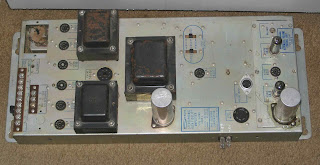I have collector friends that find very odd and interesting things. This is a Valco "Stage Star" at 27" wide, by 20" high, and 11" deep. I could barely get it on the bench, my tired out old drafting table.
It uses four 6" by 9" oval speakers, like older car speakers. You or your dad had one in the back of that 57 Chevy you were trying to score in years ago. These are "oval" speakers, popular in the 1950's as they were used in cars, because they fit into the dash or the back deck easier, due to their small width.
Here you can see the preamp chassis taking a peek outside. Using a 6SJ7 pentode for the high-gain in, and 1/2 of a 6SC7 dual triode for the rest, Valco was able to create a very adjustable preamp. Their preamps had different sounding inputs, Accordian, Guitar, Treble for a bright sound, and low for more of a bass sound.
The easy way to work on some of these big monsters is to just have it all in front of you. This amp has the output transformer mounted on the baffle board, and a solid cable between the amp and preamp, so it is easier just to take either out by itself, and work on it there
This amp is used strickly for Harp, as the amp and speakers give a nice compression and no harsh highs, good bass. Here is some of the typical simple, but mysterious wiring of a Valco preamp of the late 1950's, that gave a nice Hi-Fi sound, great for Blues or Country
The amp chassis is super simple, a 6sc7 driver, and two 5881 output tubes for a good 25 watts cathode biased, Class-A power amp, that drives the four speaks pretty fine. The 6sc7 is a metal tube, a early 6sl7 that was popular from the late 1930's to the 1950's. So this amp is still using some 1940's design motifs
What you can't see in the pics is the output transformer, which is mounted on the baffle board, so the amp can't go very far from the case unless you want to unsolder the transformer from the speakers and unscrew it from the board. Valco made small power amp chassis so they would fit between the speakers, as making even these big amps as small as possible was the way back then.
Here is the monster with it's natty cover, with the "Stage Star" initials on the left top corner. This was a custom amp made by Valco, a builder, for some small company, probably a short run as a lot of unusual designs were not big sellers. It was not until Fender, Shure, Marshall and others turned the newer music stores into big business that a large quanity of amps were sold. Also, small companies existed on the East coast or the in the midwest that sold gear that was never seen in California, land of surf music and Fender amps, and then later these unique inventions faded away
























